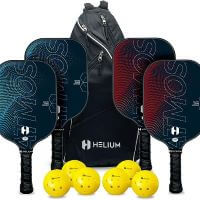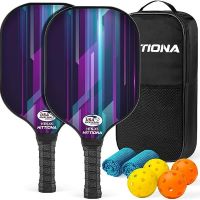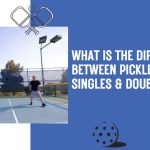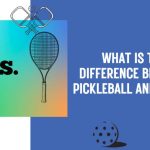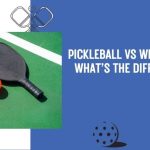If you’ve ever heard of pickleball and racquetball, but can’t quite figure out what the difference is between them, then you’re not alone. Both sports are popular amongst outdoor enthusiasts and athletes alike. But they come with their own set of unique rules and strategies. So what exactly is the difference between pickleball vs racquetball?
Both of these popular racket sports have their own unique advantages and disadvantages. So, for your reference, we have jotted down the key differences and also covered answers to the relevant questions. Let’s dig in to know better!
You Might Also Like:
What Is the Difference Between Racquetball and Pickleball?
Racquetball and Pickleball are two popular racket sports that have been gaining traction in recent years. Both of these sports involve the use of rackets and a ball, but there are some distinct differences between them. It is important for players to understand what makes each game unique. So, let’s explore the key distinctions between racquetball vs pickleball to help you decide which sport is right for you.
1. Paddles
The shape of a racquetball paddle is larger and more oblong, as compared to a pickleball paddle, which tends to be smaller with rounded edges. Additionally, the face of a racquetball racket can be made out of any material such as graphite or aluminum. Whereas, the face area on most pickle ball paddles must be made from either wood or composite material in order to meet regulation standards.
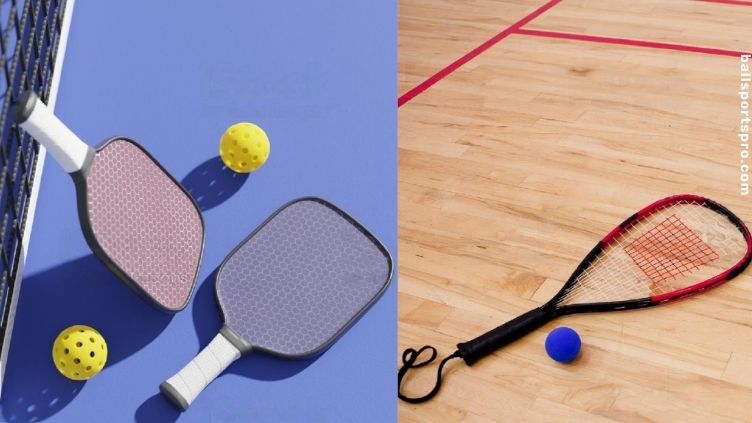
Furthermore, when it comes to grip size, most standard-sized racquets have much larger grips. Then those used for pickleball, which typically runs slightly smaller in circumference to fit comfortably in one hand.
2. Balls
The main difference of pickleball vs racquetball is the type of ball used. Racquetball balls are larger than Pickleball balls and have an inner core made of rubber. They also have raised ridges, which give them a textured surface, providing more spin when they’re hit with a racquet.
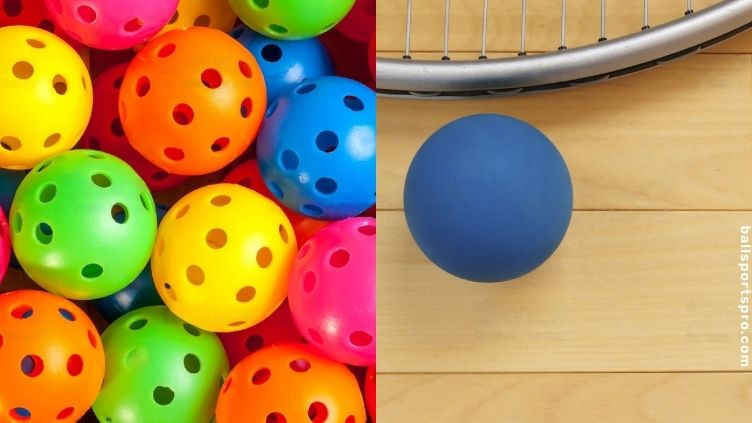
On the other hand, pickleball balls are smaller and have smooth plastic surfaces instead of ridges. It travels at slower speeds than racquetballs since their lighter weight makes them more susceptible to air resistance. Plus, racquetballs can bounce off walls while pickle balls cannot. As they don’t rebound from walls as much as racquetballs do due to their size and weight differences.
3. Courts
A racquetball court typically consists of four walls, a ceiling, and a floor. The walls provide the boundaries for play while the ceiling prevents shots from going too high. The floor is usually made up of rubber or wood to give players traction when running and turning quickly. The unique rules of racquetball require that when serving, you must bounce the ball off the wall after it has already bounced off of the floor once.
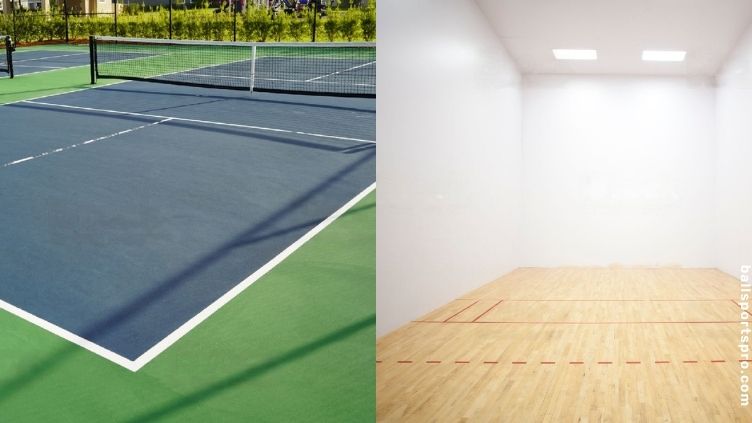
Meanwhile, a pickleball court is a flat, level surface divided into two halves by a net. The court measures 20×44 feet for singles games and 20×64 feet for doubles games. The height of the net should be 36 inches at the center and 34 inches on both sides. Furthermore, pickleball courts are typically made from concrete or asphalt, but can also be made from other materials including grass, sand, rubber mats, or tiles.
4. Serve Factor
Serving in racquetball and pickleball requires a precise technique to ensure that the service is legal. In racquetball, the player must hit the ball, so that it bounces off the floor before bouncing off of the front wall of the court. Eventually, lands behind a short line but before a back wall.
On the other hand, when playing pickleball, players are only allowed to use underhand serves, which must occur outside the baseline with at least a one-foot distance from it. All hits must also be made at or below navel height, so as not to disrupt gameplay.
5. Scoring the Game
Racquetball is played to a score of 15 during tournaments, but recreational games can opt for other scores such as 21 or 7. When playing racquetball, the rally continues until one player fails to return the ball to the front wall. Or carries it with their racquet, at which point the server wins a point.
Meanwhile, pickleball has one very important rule, only the serving team can score, and they must win by at least 2 points in order to be declared victorious. Games of Pickleball are typically scored up to 11 but may be extended up to 15 or 21 depending on the game.
Can You Play Pickleball on a Racquetball Court?
The short answer is yes, you can play pickleball on a racquetball court. Pickleball and racquetball are both similar racket sports, that involve hitting a ball with a paddle. But, there is a difference in the size of the court and the equipment used. Pickleball courts are slightly smaller, and paddles for pickleball are shorter than those for racquetball. The net height also differs slightly between the two sports, but it is possible to adjust the net to accommodate either game if necessary.
Overall, playing pickleball on a racquet court is perfectly fine, just be sure to adjust the net accordingly.
FAQs
Well, it is not recommended to use a racquetball racket for the pickleball game. This is because there are some slight differences between the two, a racquetball racket is slightly larger and heavier than a pickleball paddle, so it might not be comfortable to use it for a pickleball game. Additionally, the racquetball racket has strings, which could affect your ability to control the ball and spin when playing pickleball with this type of racket.
Yes, there are some common skills in pickleball and racquetball. Both sports require a good sense of hand-eye coordination, agility, and quick reflexes. They also share some basic strategies such as reading the opponent’s shot and anticipating their next move. In addition to these physical skills, both games require players to have good court positioning and strategy in order to be successful.
Well, It’s a Wrap!
To sum up, in our blog: Pickleball vs Racquetball, it is clear that both differ in terms of court size, equipment needs, scoring system, and serving factor. While they both include a net, court, and racquet, the games are played differently with different rules and strategies.
Furthermore, pickleball is an easier game to learn, than racquetball due to its slower pace and larger court size. It is also a less physically demanding sport as players don’t need to move around the court as much as they do in racquetball.
However, both sports can be equally enjoyable depending on individual preferences. Pickleball may suit those who prefer a more casual atmosphere, while Racquetball may be better suited for those looking for an intense competitive atmosphere.
Ultimately it comes down to personal preference when deciding, which sport is right for you!

I am the founder of BallSportsPro, a popular pickleball resource for players of all levels. I am a former professional tennis player, started playing pickleball in 2009 and quickly fell in love with the game. I launched BallSportsPro in 2018 to share my passion for the sport and to provide pickleball players with the latest news, tips, and gear reviews. Today, BallSportsPro is one of the most popular pickleball resources on the web, reaching hundreds of thousands of players each month. In addition to running the website, I also a regular contributor to Pickleball Magazine and a member of the USAPA Pickleball Ambassadors program.

